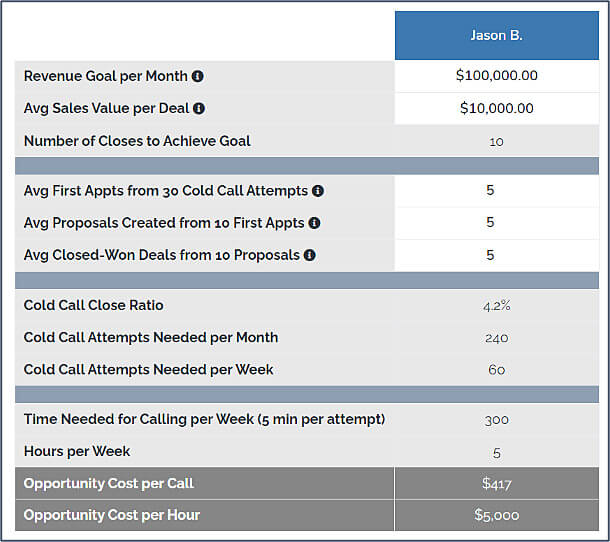By Kristi White
The time to get back to selling is here. That means sellers should be focused on prospecting rather than being dragged into operations needs or busy work. But how is this accomplished, and how can it be maintained?
It must start with sales leaders doing what is necessary to protect selling time vehemently. To do this effectively, you need to speak in a language that makes sense to owners and operators. That language is cold, hard Benjamins.
A brief history
Let’s break it down. If you are familiar with the book “Moneyball,” you know the secret to the Oakland Athletics’ success in the early 2000s was to break down their (comparatively) minuscule budget for players, to recruit overlooked players who would give them the best chance to win.
They analyzed every metric needed to win and then searched for the players to help them achieve it. It meant every metric had a dollar value. This helped quantify each statistic and place a value on things the league had never really valued. Billy Beane focused on two metrics, on-base percentage (the times a player gets on base for any reason—excluding errors) and slugging percentage (total bases divided by at-bats). Beane believed these two metrics answered two questions. Can the player hit? Can the player create runs?
Data analytics was nothing new to baseball. Baseball has been tracking statistics since the 1800s. What Beane (and his team) did was distill it into the metrics most likely to win. He eschewed the power players for players who consistently made it on base. Fortunately, these players also cost less. This created an entirely new way to manage baseball teams that successfully allowed lower-market teams to compete with big-market teams.
What does that have to do with sales?
What does a complex baseball theory have to do with sales? The short answer is nothing. The shorter answer is everything.
Think about where we are as an industry. We have sales teams distracted by RFP spam inundating inboxes. The same lead that used to go to six to eight hotels now goes to 20 to 25. This means hotels are getting more unqualified leads. But as sales teams are often measured by response time, it’s the perfect excuse to stay “busy.”
Compounding the issue, our operations teams are still understaffed. This means sales teams get dragged into helping in operations. Additionally, we have newer sellers who are afraid of NO! They believe prospecting will take too much time. Ultimately, they don’t know what it takes to sell vs. take orders.
This is where Moneyball comes into play:
- Sellers need to know what effort they must put in to achieve their revenue goals.
- Leaders need to know how sellers are performing and who is optimizing their efforts.
- Operations need to know the “cost” of redirecting sales from sales into other activities.
So, how do you accomplish that? The same way Billy Beane did. You’ve got to analyze the data. This is not the time for group goals. This must be done at the individual seller level. And it requires a maniacal focus. Managing and leading a team goes beyond looking at the top-line numbers. You must have a plan and visibility for each and every person on your team, and across the various tasks for which they are responsible. The outcome is closed deals, and it takes a calculated level of effort to get the desired results. Knowing how many calls, leads and proposals it takes to achieve your desired goal is what every seller needs to understand.
A sales calculator, like the example below, is a great tool to help you understand the value of your selling time.
Sample sales calculator
In this example, “Jason B.” has a monthly quota of $100,000 and requires 240 cold calls across five hours a week to hit his goals. If Jason is pulled away from selling, the opportunity cost is $5,000 per hour. The conclusion: Jason’s time is better spent on selling, versus servicing activities better delegated to the operations team. Try this interactive sales calculator live by clicking here.
What does this do for you?
This works across multiple levels for your organization.
- For sellers, it sets the expectation of what they need to do to achieve their goals. It creates achievable and realistic numbers to help them understand the time commitment required to be successful.
- For leaders, it helps clarify where a seller’s strengths lie and how to help if they don’t achieve their goals. If a seller is great at setting appointments but has a low, close percentage, coach them through how to qualify proposals better to achieve better close rates.
- For operations, they can begin to understand the cost of derailing prospecting time. In the last row of the table above is an opportunity cost. Every hour your property seller is not on the phone is the potential for lost revenue.
Now what?
Believe it or not, the math of this is easy. Implementing and maintaining it is where the real work comes in. However, none of it is rocket science. And all of it is something our industry needs to get back to—managing by contributor and measuring the negative revenue impact of “multi-duty” sales teams.
- Clean up your sales and catering system. Every lead, call, appointment, etc., should be entered and moved along the pipeline effectively. This is simply good lead management hygiene. However, too often, sellers don’t keep up with it. They enter the leads they believe they can close but not the rest. This means there is no clear understanding of demand or a way to go back and mine your own data sources for opportunities in the future. Additionally, this practice will help track activities to monitor the efficacy of sellers.
- Invest in tools to help the team sell. Sellers must identify good leads to understand better which organizations buy your type of hotel. Knowing this will make their calls more efficient. This is important at all stages of the pipeline funnel. Calling organizations with buying attributes that match your hotel means more appointments, proposals, and, ultimately more closed-won deals.
- Revamp your RFP process. Not all RFPs are created equally. The same tool that helps make the sales team more effective at prospecting can help determine how much time to spend on an RFP. Consider having lead catchers whose sole responsibility is bucketing RFPs based on the likelihood of closing:
a. No Go – Not a fit for your hotel and should be turned down immediately.
b. Minimal Opportunity – Require a perfunctory proposal with rates, dates and space.
c. High Opportunity – Deliver a highly personalized proposal with individualized follow-up. - Schedule time. Each seller should have dedicated, sacrosanct time booked on their calendar for prospecting. This time should be easily identified to everyone and protected at all costs. For every minute they aren’t selling, money is lost.
- Monitor everything. Every seller will evolve over time. Make sure the metrics are tracked to help identify when someone is struggling. Then intervene with coaching to steer them in the right direction.
- Remove distractions. Reevaluate all internal time stealers and take back time for sellers. Look at internal meetings and decide who needs to be where. Does everyone need to attend the Daily Business Review (BDR), the Banquet Event Order (BEO) meeting, etc.?
- Align everyone. The entire staff (not just sellers) needs to understand how vital it is that sellers are prospecting and not just busy.
Moneyball was about using data to create winning teams. Sales is much the same. Sellers have to make the calls; that much is true. But with the calls, they need to set appointments. From the appointments, they need to send proposals. And, from the proposals, they need to close business.
Much like Billy Beane and his two metrics (on-base and slugging percentages), sellers can be tracked with four metrics: calls, appointments, proposals and closed-won deals. Measuring sellers against these metrics and holding them accountable will lead to more active pipelines and more revenue. Once you commit to that and show the results, you will find that operations will find other people to answer phones.
Kristi White is chief product officer, Knowland. With two decades of experience in the hotel and revenue management side of the industry, she has advised hundreds of hotels worldwide on improving their business strategy, hotel performance and overall profitability.
This is a contributed piece to Hotel Business, authored by an industry professional. The thoughts expressed are the perspective of the bylined individual.


